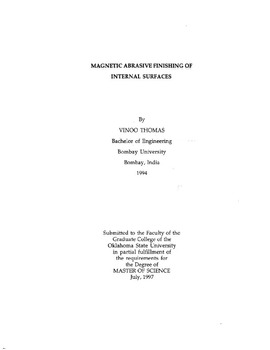| dc.description.abstract | The creation of smooth internal surfaces has wide applications. Conventionally this is done using the process of internal grinding. There are certain disadvantages associated with internal grinding as a process, namely the comparatively large force exerted by the grinding wheel and the difficulty of making and maintaining complex shapes on the wheel. This precludes the finishing of thin walled components and complex shaped internal surfaces. Magnetic field 'assisted finishing (MAF) is a process which overcomes these hurdles. The major advantage of this process is the reduced forces and ability to finish complex internal shapes. In MAF the tool is composed of a flexible brush of magnetic abrasives and iron particles under the influence of a known magnetic field. The workpiece rotates, while either the workpiece or the flexible brush is reciprocated. Material removal is effected by the relative motion of the abrasives and the workpiece. In the present work, the objective was to develop a technique of internal finishing using conventional abrasive products in lieu of magnetic abrasives. The permanent magnet design was adopted due to its light weight construction. A systems approach involving design of equipment and process studies to determine optimum conditions was used. Using the technique pipes of 12.7 mm O.D. and 9.9 mm I.D. were finished to an Ra of 20 nanometers over a length of 25.4 mm. The work materials polished were AS304, A272, and A6061. The times for polishing were 4, 2, and 3 minutes respectively. The design methodology developed started with a preliminary geometric design based on the pipe diameter. Next, FEM analysis of the magnetic field was conducted to determine the placement and shape of the magnets to be used to give maximum field intensity at the polishing zone. After this was done a force analysis was carried out to find the reciprocation amplitudes needed for the different air gaps. Parametric tests were conducted to determine the effects of spindle speed, polishing time, abrasive , type, reciprocation frequency, iron concentration in mix, and zinc sterate (solid lubricant) concentration in mix on material removal rate and surface finish. These studies establish certain optimum conditions to obtain the best results with existing setup. The present work has demonstrated that the process of MAF of internal surfaces can be applied to different work materials. | |
